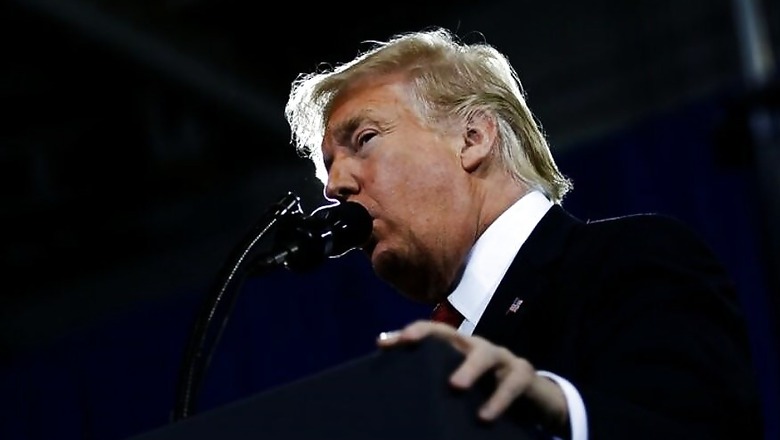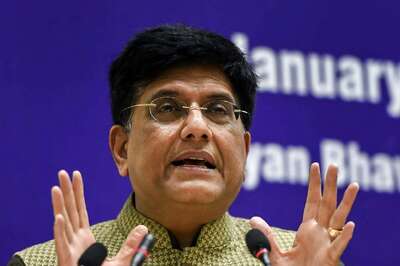
views
Washington: President Donald Trump asked the U.S. Congress on Thursday to approve a 2018 budget that would bolster military programs and begin building a wall on the southern border with Mexico while drastically cutting many federal agencies.
Trump's plan, showcasing his administration's priorities, is just the first volley in what will likely be an intense battle over spending in coming months. Although both the Senate and House of Representatives are controlled by Trump's fellow Republicans, Congress holds the federal purse strings and seldom approves presidents' budget plans.
Trump's plan took a big swipe at some federal institutions, envisaging a more than 31 percent cut, or $2.6 billion, for the Environmental Protection Agency and a 28 percent reduction, or $10.9 billion, for the State Department and other international programs.
In a message with his budget submitted to Congress, Trump said he aimed to advance "the safety and security of the American people," adding he would do so with $54 billion in added military spending next year and putting more money into deporting illegal immigrants.
Predictably, Democrats denounced the proposed steep cuts to spending on domestic programs. But some prominent Republicans were also quick to criticize the budget.
Protecting national interests requires a comprehensive approach, "including not just military engagement but also the full and responsible use of all diplomatic tools at our disposal," said Republican Representative Hal Rogers, who chairs a panel that oversees State Department and foreign aid spending.
Under Trump's plan, funding would disappear altogether for 19 independent bodies that count on federal money for public broadcasting, the arts and regional programs from Alaska to Appalachia.
Moderate Republicans expressed unease with potential cuts to popular domestic programs such as home-heating subsidies, clean-water projects and job training.
Trump's budget outline covered just "discretionary" spending, or programs that must be renewed annually by Congress, for the 2018 fiscal year starting on Oct. 1.
It did not address mandatory "entitlement" programs, such as Social Security retirement benefits and federally-backed healthcare for the elderly, poor and disabled, that make up most of the federal budget. For years, conservatives have been clamoring for reforms to these programs to save money.
Trump also asked for $25 billion more for core Defense Department programs for the current fiscal year, as well as $5 billion more for combat operations. A detailed copy of this request seen by Reuters showed some of the added funds would be for procurement of technology such as F-35 fighter aircraft and drone systems.
About $13.5 billion of the supplemental request was earmarked for aircraft, missiles and ships. It included THAAD missiles, Blackhawk helicopters and F-35s made by Lockheed Martin Corp, as well as F/A-18 warplanes and Apache helicopters manufactured by Boeing Co.
Also for this fiscal year, Trump requested $3 billion more for the Department of Homeland Security, with some of that money intended for planning and construction of the border wall that he made a major part of his 2016 election campaign.
Congress will likely consider the supplemental request by April 28, when regular funding expires for most federal agencies.
OPEN FOR DISCUSSION
On the 2018 budget, Trump is willing to discuss priorities with Congress, said White House budget director Mick Mulvaney, a former South Carolina congressman who made a name for himself as a spending hawk before he was picked to join Trump's Cabinet.
House Democratic leader Nancy Pelosi blasted the plan, saying, "Throwing billions at defense while ransacking America’s investments in jobs, education, clean energy and lifesaving medical research will leave our nation weakened."
Moderate Republicans expressed unease with potential cuts to popular domestic programs such as home-heating subsidies, clean-water projects and job training.
For years, conservatives have sought many of these proposals, only to see them defeated amid opposition from Democrats and some moderate Republicans. It was unclear whether Trump will have more success.
The budget outline does not incorporate Trump's plan for sparking $1 trillion in investments to build roads, bridges, airports and other infrastructure projects. The White House has said the infrastructure plan is still to come.
The planned defense increases are matched by cuts to other programs so as to not increase the $488 billion federal deficit.
Mulvaney acknowledged the proposal would likely result in significant cuts to the federal workforce, saying, "You can’t drain the swamp and leave all the people in it."
Reflecting Trump's repeated election campaign pledge to reduce illegal immigration, the Department of Homeland Security would get a 6.8 percent increase, with more money for extra staff needed to catch, detain and deport illegal immigrants.
WALL MONEY
Trump wants Congress to approve $1.5 billion for the border wall in the current fiscal year - enough for pilot projects to determine the best way to build it - and a further $2.6 billion in fiscal 2018, Mulvaney said.
The estimate for the total cost of the wall will be included in the full budget. That more detailed document is expected in mid-May and will project spending and revenues over 10 years.
Trump has repeatedly said that Mexico will pay for the wall, and Mexico has adamantly said it will not. Since Trump took office in January, the White House has said funding would be kick-started in the United States.
The full budget plan will include economic forecasts and the president's views on "mandatory entitlements" like Social Security and Medicare, which Trump vowed to protect while he was on the campaign trail.
Despite the proposed big cuts to the EPA and the State Department, Mulvaney said their "core functions" would be preserved. Hit hard would be foreign aid, grants to multilateral development agencies like the World Bank and climate change programs at the United Nations.
Trump wants to get rid of more than 50 EPA programs, end funding for former Democratic President Barack Obama's signature Clean Power Plan aimed at reducing carbon dioxide emissions, and cut research programs on renewable energy at the Energy Department.
Other reductions and cuts included community development grants at the Housing Department, which have been around since 1974, more than 20 Education Department programs, anti-poverty grants and a program that helps poor people pay their energy bills.
Trump's rural base did not escape cuts. The White House proposed a 21 percent reduction to the Agriculture Department, including reducing staff in county offices and ending a popular program that helps farmers donate crops for overseas food aid.



















Comments
0 comment